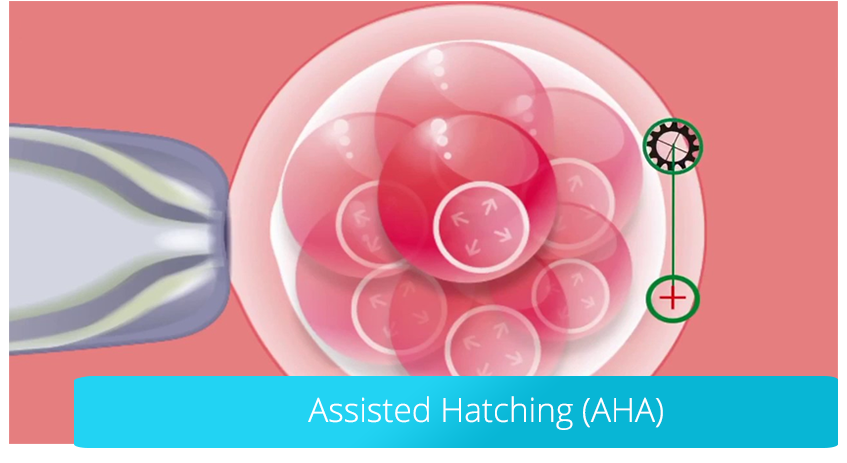This process, also called Assisted Nesting; is the application of the laser to help the embryo to separate itself from the enveloping membrane (zona pellucida).
Assisted Hatching (AHA) technique helps the embryo to hold onto the uterus.
Assisted Hatching (AHA) can be applied in recurrent IVF failures.
It is thought that this method can improve the results in cases where the female age is over 38, the membrane surrounding the embryo is thick, the FSH hormone level in the woman is high and there is no result in repeated in vitro fertilization trials.
In this method, an artificial hole is drilled in the outer shell of the embryo before the embryo is transferred.
How is assisted hatching done?
During assisted hatching, the outer shell of the embryo is artificially weakened by making a small hole in the zona pellucida. This can be done in several different ways. One method involves the application of an acid solution, called Tyrode’s solution, to help melt a small hole in the shell. Another method involves the use of a laser to “crack” the shell.
Can assisted hatching cause problems with my embryo or pregnancy?
Rarely, assisted hatching can damage the embryo, making it unusable.
The risk for identical twins might be slightly increased when assisted hatching is applied. Medical complications are higher in identical twin pregnancies than in normal, singleton pregnancies.
Medicines such as antibiotics and steroid hormones are sometimes prescribed around the day of the assisted hatching and embryo transfer. Uncommonly, side effects can occur from the use of these medications.
Will I benefit from assisted hatching?
Experts do not recommend the use of assisted hatching in all patients undergoing IVF treatments to conceive. Studies suggest that assisted hatching might help improve pregnancy chances for certain groups of patients. Assisted hatching may help improve pregnancy chances in women who have failed to get pregnant in previous IVF cycles and those with a poor prognosis (who are not likely to conceive).
Your health care provider can help you determine if assisted hatching might be useful to you.
Are there other reasons to do assisted hatching?
If preimplantation genetic diagnosis (PGD) is planned, assisted hatching of embryos on the third day after fertilization can make a biopsy for PGD easier. During a biopsy, a small amount of tissue is taken from the outer cells of the embryo (trophectoderm) around the fifth day after fertilization (blastocyst stage). It is easier to see the trophectoderm and remove the cells in a hatching embryo.
What is Assisted Hatching?
There is a protective membrane around the egg and the embryo formed after fertilization. This membrane is called zona pellucida.
This membrane has many important tasks. But; attachment of the embryo to the uterus begins by hatching the embryo out of this membrane in the glycoprotein structure surrounding the embryo. The budding takes place on the 5th or 6th day of embryo development after reaching the blasttocyst stage. It is only possible to hold the embryo in the uterus when it is completely removed from the membrane.
There are studies showing that the drugs used for IVF thicken the membrane surrounding the embryo or culture media where embryos develop within it harden the membrane. Therefore, in in vitro fertilization applications, especially in frozen thawed embryos, the thinning or opening of the membrane surrounding the embryo may facilitate the budding of the embryo. This process is called Assisted Hatching (AHA) and can be performed in 3 different ways.
Assisted Hatching Methods
1-) Mechanical; open the membrane of the embryo with a glass microneedle.
2-) Chemical; Using the acid tyrode solution, the membrane surrounding the embryo is thawed from a certain region or thinned or fully opened.
3-) Laser; The membrane is thinned or apertured by laser.
Laser assisted hatching method is used in our center.
It is the most practical method performed as soon as possible.
Who should consider AHA?
Assisted Hatching has been suggested for infertile couples if:
- The women is 38 years or older;
- The woman has a high FSH level;
- The woman has poor egg quality;
- They have had poor embryo quality
- They have failed to become pregnant in prior IVF cycles;
- They are using frozen-thawed embryos in a Frozen Embryo Transfer (FET) cycle
Assisted Hatching How to apply?
During early development, the embryo is covered with a protective layer called ‘zona pellucida’. In the following periods, the embryo should break out of this layer. Otherwise, there is no chance of pregnancy by sticking to the endometrium of the uterus.
The assisted hatching method facilitates the exit of the embryo by opening a small hole in the shingles layer surrounding the embryo. This is usually done on the 3rd day of embryo development.
For the assisted hatching process, laser energy is used in Acıbadem IVF Centers so that the sensitivity of the process is increased significantly compared to chemical methods.
The risk of direct damage to the embryo during the procedure is very low. An increase in single twins was observed in the pregnancies developed after the procedure and this occurs in 2 out of every 100 treatments.
The assisted hatching method is thought to increase the chance of pregnancy in some older women who have had recurrent IVF failures, high FSH values and advanced age. In this group, it was observed that the shingles layer was thicker than normal and made it difficult for the embryo to exit. Thickening of the shingles is also possible in frozen embryos.


Add Your Comment